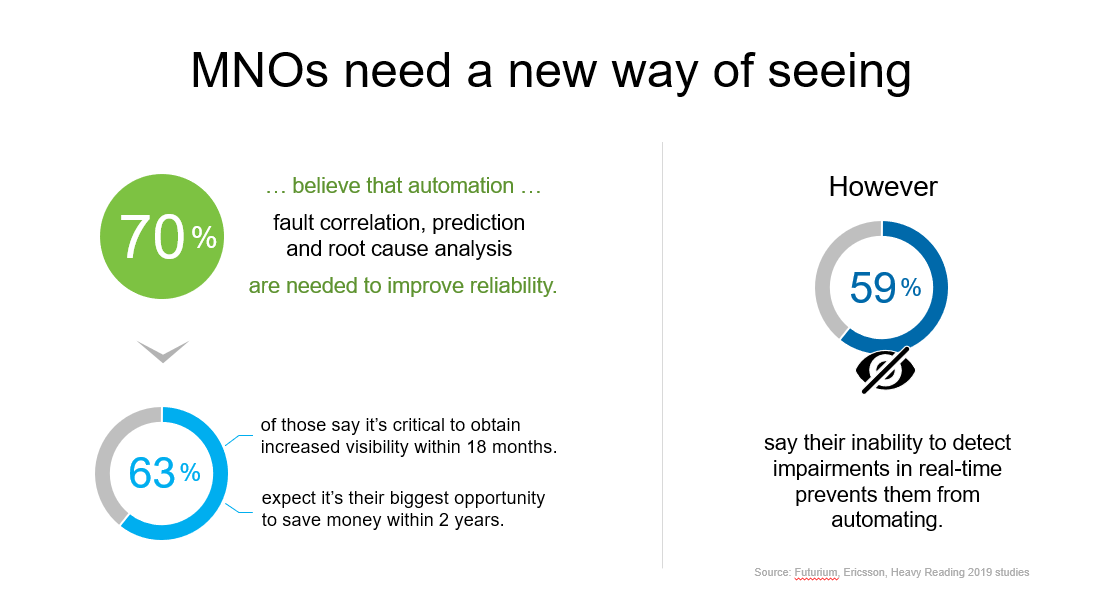Failure is not inevitable: how network operators can automate successfully without destroying profits
By Mae Kowalke
Thinking a lot about seemingly lose-lose scenarios lately? Let’s embrace that sentiment by exploring an example straight out of the telecom world. Spoiler: there's a happy ending for those willing to think outside the box.
Imagine, if you will, that to survive long-term, the company you work for—and most others in the same industry—must embark on a significant project that will take 3-5 years to complete and has only about a 1-in-3 chance of success. The price tag? An entire year's worth of your company's operating profit.
Ouch. Really wouldn't want to be the person presenting this to their bosses with imperative to convince them it must be done, despite the costs and risk.
Now, let's back up and fill in the gaps by attaching labels to those numbers and fleshing out the story.
Network operators experience 7-9 major outages per year (Heavy Reading, 2019). These short-lived outages, though, are only the tip of the iceberg: 96% of customer impacting issues are caused by degradations, not outages (Heavy Reading, 2019). Ongoing dissatisfaction with service quality is what usually causes customers to get fed up and switch providers.
In the face of overloaded network operations centers (NOCs) and service operations centers (SOCs) that lack visibility into the customer experience, 70% of providers plan to establish automated, self-driving networks within 24 months (Futuriom, 2019). They expect that doing so will help them manage the inter-related challenges of thin profit margins, high churn rates, and the complexities of running hybrid networks.
There's a problem, though.
While 91% of providers believe real-time monitoring is essential for automation (Futuriom, 2019), 59% say siloed systems impair their ability to automate (Ericsson, 2019). Relatedly, 50% of operators can't correlate data across layers, domains, and physical and virtual networks (Heavy Reading, 2019). Uh-oh! Accurate data and real-time input—which go hand-in-hand—form the foundation of automation.
It's really no wonder these numbers are so dismal; 80% of operators use up to 9 different inventory systems! (Heavy Reading, 2019.) Across many industries, inventory systems are notoriously prone to inaccuracy. (We'll look at that problem more closely in another blog post soon.) The number of systems in play significantly exacerbates the problem.
Addressing issues with inventory systems brings more bad news. To implement a cross-domain inventory consolidation project costs about $0.5 billion! (Typical for Tier 1 North American operator.) That's the entire annual operating profit of a Tier 1 U.S. mobile operator. Why so expensive? Among other things, it usually involves 50-100 people or so working on data grooming and takes 3-5 years to complete (source). Also, 71% of such projects fail (Heavy Reading, 2019).
So, here's the situation: operators must automate to prevent churn and OpEx from driving them out of business. (Profits from 5G won't kick in soon enough to save the day without other efforts in the shorter-term.) But automation depends on accurate-real-time data and the plethora of inventory systems in use, with their tendency to be inaccurate, makes this nearly impossible. Fixing the data inaccuracy problem using conventional methods is simply cost-prohibitive.
What's the solution? It sounds cliché to say "think outside the box," but the truth is you can't solve intractable problems with the same (expensive) solutions that have been tried unsuccessfully before or that logic says are unlikely to succeed.
There must be a better way! And there is. It means embracing bleeding-edge technology like the large-scale graph databases used by social media companies. Operations teams need new tools to cut through the complexity and see customer issues in real-time. This requires a clean federated inventory view to deliver the needed context. The technology exists now to make this possible.
Watch our podcast episode above, for a more in-depth exploration of this topic.

